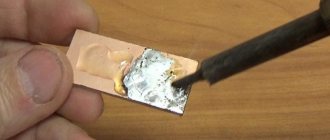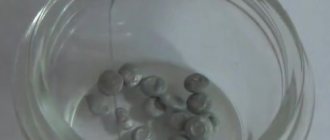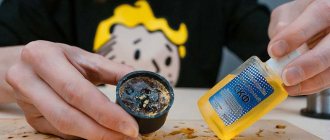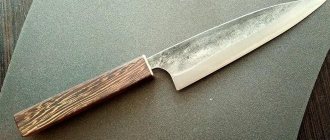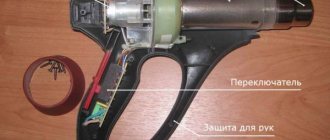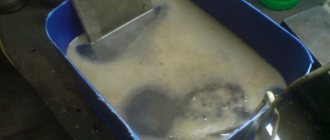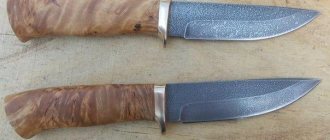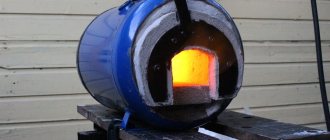Physico-chemical properties and composition
Resin is a solid; to make it liquid, a natural solvent must be added. Usually they take hydrolytic or medical alcohol. Propanol and some other elements are added to the mixture to impart special properties to the material. If the products are mixed correctly, the resulting mixture will look like a homogeneous mass.
The amount of rosin affects the density of the solution. According to its characteristics, the liquid product is the same as solid tallow rosin.
Main properties of the finished substance:
- excellent fluid fluidity;
- penetrates into all cracks and pores present in the metal;
- forms high adhesion between parts.
The substance is not harmful, does not act aggressively on metal surfaces, so it is suitable for any parts.
Due to its good fluidity, liquid rosin is convenient to work with
How to make liquid rosin
Rosin is a natural material that is obtained from the resin of coniferous trees by evaporating turpentine. After processing, a solid translucent resin is obtained, which is used as a soldering flux. Rosin is used not only in its pure form, but also in combination with various chemical additives. Rosin is mainly used in amateur radio as a cheap and high-quality flux. For soldering radio components and tinning printed circuit boards, it is very convenient to use an alcohol solution of rosin. Liquid rosin easily penetrates into all hard-to-reach places, both when soldering SMD components and conventional radio components, does not leave dirty marks on the board and, if necessary, is easily washed off with acetone or alcohol. Rosin easily dissolves the film of oxides formed on the surface of radio elements during the soldering process, and also reduces the surface tension of the solder melted by the soldering iron tip, allowing it to spread evenly over the entire surface of the soldering area.
In radio stores, the shelves are simply full of various expensive and cheap, chemical, acidic and natural fluxes based on pine rosin. There's a lot of choice, I don't want to take it. But as a real radio amateur, for the sake of experiment, I wanted to prepare an alcohol solution of rosin with my own hands. As my grandfather, an avid radio amateur, did.
Enough words, now I’ll start my experiment, I just can’t wait to see what happens in the end...
As always, I prepared very carefully for the experiment: I took two 20 grams. jars of pine rosin, 100 ml. pure 96° alcohol and an empty plastic bottle for preparing liquid rosin.
You definitely need to take new and clean rosin; dirty rosin, burnt by a soldering iron tip, will not work, because it will contain a lot of dirt and all sorts of impurities. Rosin can be dissolved in anything, in acetone, in all sorts of strange solvents, even kerosene. But the safest and non-toxic solvent for rosin, as you may have guessed, is 70° medical alcohol; you can also use 96°, it will dissolve even faster.
The rosin must be thoroughly crushed, I do this with such powerful pliers, right in the jar. The compression of the rosin crumbles into small pieces, which is very convenient; there is no need to do anything shamanic with glasses, mortars, crushers and other crap.
Now I pour it into a plastic bottle. There are exactly two jars of rosin here.
I fill this whole thing with alcohol, one to one. I have two jars, which is 40 grams of rosin, which means you need to pour in at least 40 milliliters of alcohol, maybe a little more. As they say, by eye. If all the rosin is not dissolved, I will add more. For such an interesting experiment, I donated a bottle of pure alcohol. What won't you do for the sake of science? Now I’ll mix this whole thing thoroughly. After about an hour, all the rosin should dissolve.
After an hour, the rosin had completely dissolved, resulting in a homogeneous, transparent honey-colored rosin-alcohol solution with a pleasant smell of pine rosin.
And now, as always the most interesting thing, I’ll see how liquid rosin will solder.
It turned out not bad, even better than store-bought flux (LTI-120, KE, FKEt, FKSp and so on), one might say it’s a little thicker.
Liquid rosin works, the experiment was a success! It solders perfectly and has such a pleasant light rosin smell. I'm just delighted!
Friends, I wish you good luck and good mood! See you in new articles!
I recommend watching a video on how to make liquid rosin with your own hands
What you need for cooking
Before you start working on creating liquid rosin for soldering, you need to prepare all the ingredients and tools. For melting you will need rosin, water to dilute the thick mixture and alcohol. The tools you will need are:
- a gas stove or a special burner; solid pieces and liquid will be heated on them until they dissolve;
- a spoon to stir and dose the substance;
- a cup or mortar where rosin is crushed until fine;
- wooden masher;
- a jar for storing the resulting crushed flux.
Materials and tools for manufacturing
Before melting rosin, you need to prepare by selecting the required number of materials and tools. As consumables, you will need the brand of rosin itself, alcohol, and water if you need to dilute the material.
The tools you will need are:
- A burner or gas stove on which you can heat the liquid for subsequent dissolution;
- Spoon for mixing and dosing the created powder;
- A mortar or other container where you can crush solid rosin into crystalline powder to the finest possible state;
- An object that can be used to crush solid rosin in a mortar;
- Container for storing prepared flux.
Technology and proportions
Considering further points on how to dissolve rosin at home, you should dwell in more detail on the practical part. First of all, you should start by preparing the rosin. It needs to be split into small pieces and then crushed to a powdery state. This is necessary so that the material dissolves better and faster during the process.
Ground solid rosin
The substance itself is very fragile, so there should be no problems with this process. Liquid rosin should not have sediment.
After obtaining the crystalline powder, or during the start of its preparation, you should begin to heat the solvent. The higher its temperature, the faster it will act. The proportions may vary, but most often they take 60% solvent and 40% powder. When the liquid has reached the desired temperature, you can begin to mix the powder. Gradually stirring the substance with a spoon, you need to wait until all the particles turn into a liquid state. At the same time, the mixture should change color to yellowish.
You can add the powder to the solvent until a precipitate begins to form. This means that the ability to dissolve has already come to an end. To increase this parameter, you need to increase the temperature or volume of the liquid. Once you have prepared the required amount of rosin, you can let it cool if everything is very hot, or use it right away. In this state, the material can be stored for quite a long time.
How to choose the right flux
Even with knowledge of the varieties and technical characteristics, not every person understands how to choose a flux. For safe soldering, neutral fluxes should be chosen. They are suitable for working with a variety of parts, but when soldering large components, the work will be slow.
To speed up the process, you can use medium-active fluxes. Such compositions are suitable for working with various metals. For working with large parts, silver solders are ideal.
The best substitutes
It is not always possible to find solder at home to solder broken contacts or wires. In such situations, repairs can be carried out without purchased compounds. You can replace flux with several substances:
- amber;
- fat;
- "Aspirin";
- resin.
Before starting work, Aspirin must be dissolved in a small amount of liquid.
Resin on wood
Purpose of rosin
Before describing the purpose of rosin, it is necessary to explain the difference between soldering and welding:
- During the welding process, the edges of the parts being joined are melted, the liquid phases mix and, when solidified, form a permanent connection.
- When soldering, the parts to be joined remain in a solid state, and only the metal used for the connection—the solder—melts. The molten solder spreads over the edges being joined and, when solidified, forms a permanent connection.
To guarantee quality, the edges of the parts to be fastened must be well wetted with solder. This is achieved by cleaning them from oxides and contaminants using fluxes - in this case, rosin.
Fluxes made from hydrochloric and phosphoric acid
You can also make two active fluxes for soldering, using hydrochloric and phosphoric acid for these purposes. The first flux recipe is prepared using hydrochloric acid and zinc granules, which dissolve in it. For one liter of hydrochloric acid you will need about 0.5 kg of zinc granules.
Even steel products can be soldered with a flux based on hydrochloric acid and zinc. Also, ammonia is often added to the composition of this flux, the same percentage as zinc granules. In this case, the flux can be used for soldering various metals.
A good flux for soldering stainless steel and nichrome can be made from phosphoric acid. You need to apply liquid fluxes with a thin brush, and solder using them only in a well-ventilated room. As for storage, acid-based fluxes are stored in closed glass containers with a narrow neck.
What is the disadvantage of regular rosin for soldering?
Rosin is obtained from coniferous trees by making cuts in the trunk. Next, all excess components are evaporated, and only those that make up the original mass of pine resin remain. So, as a result of simple manipulations, we get rosin, which we are all used to soldering with.
In principle, rosin is an excellent flux. Perhaps its only drawback is that it is hard and fragile. To solder with regular rosin, you first need to heat up the soldering iron and then dip its tip into the rosin. This will allow it to melt and then be used for soldering.
Therefore, without thinking twice, the craftsmen came up with a composition of liquid flux based on rosin. It has many more benefits than regular solid rosin.
Instructions for making flux
So, how to make soldering flux with your own hands? It all depends on the destination. If you need to solder thin wires, you can use rods with a diameter of 1 mm. We will make them ourselves.
We will need a small bottle or any other vessel with a flat bottom. We make a hole in the bottom with the diameter we need (in this case 1-2 mm). We take lead or tin and melt it using a gas burner. Pour it into our bottle. Molten metal will begin to flow out of the hole; you need to prepare the surface in advance. You can use a sheet of tin, for example. The resulting “rods” must harden, then they need to be cut. Experienced craftsmen use special molds to make rods. Also look at the review of bga soldering flux. There are also liquid fluxes, fluxes in the form of a gel or paste. They are now very popular and are available from any manufacturer. This is not surprising, because such fluxes do not cause oxidation, prevent the formation of corrosion, do not conduct current, and the soldering area does not need to be cleaned after work. This flux can also be made at home.
We will need rosin crystals, which need to be crushed into powder. Wrap the crystals in a thick cloth and tap them with a hammer (preferably a wood hammer or a meat mallet). Mix the powder and alcohol in a one to one ratio. Alcohol can be purchased at a pharmacy. It is advisable to mix in a glass container, such as a small jar. Thoroughly mix the alcohol with the powder and place the jar in hot water. Mix everything thoroughly again until it has a homogeneous consistency. Ready! The resulting flux can be used with a medical syringe or poured into an empty nail polish bottle.
Soldering may release substances that are hazardous to your health. Use protective gloves, a mask and goggles in your work. Do not purchase fluxes from little-known manufacturers, do not chase the lowest price. If possible, make your own flux. Follow safety precautions. This way you will reduce the likelihood of poisoning from flux vapors.
Types of rosin
- Zhivichnaya.
- Extraction.
The first type of rosin is obtained from coniferous trees. This is their sap. In the Russian Federation, such extraction is carried out mainly from pine. This substance remains after turpentine has been extracted from resin. It consists largely of terpenes.
As for the second type of rosin, it is extracted through the extraction of rosin, which is possible using organic solvents.
How resin is formed in pine is not yet clear. But when it is fresh, just appearing on the surface of a tree trunk, then it has a light color with a viscous structure. After some time during storage, the liquid thickens. Then resin acids can be extracted from it. If rosin is primary, it means it was obtained from fresh acid, but if it was obtained as a result of isomerization, then such rosin is called secondary.
Arbuzov has long reported that the primary rosins created from resins are dextropimaric, levopimaric and a-sapin. In the background is the isomerized acid, which is in the foreground.
There are two types of such acids.
- Abietic acid.
- Dehydroabietic acid.
The first variety of rosin is considered the best and most durable. It was this acid that was discovered when the temperature of this substance increased.
The material in question is quite stable. It can be used in an industrial environment. But more than one type of alcohol can dissolve it, including ethyl, benzene, and oil with ether.
Ointment with beeswax and rosin
Rosin is a light yellow, brittle and hard substance that consists of resinous substances obtained from coniferous trees after distilling off turpentine. Depending on what type of raw material it is obtained from, it comes in different types. Resin rosin is obtained after distilling turpentine from purified resin. Extraction - after extraction of resinous wood, most often pine, with gasoline. Talwood is prepared by the method of fractional distillation of tall oil.
Wax is a unique beekeeping product. It is produced in the body of worker bees and is secreted onto the surface of wax mirrors, where it hardens in the form of wax scales, which serve as material for honeycombs. At different times of the year the product has a different color. In spring it is white, and by autumn it turns yellow, sometimes dark brown.
Ointments for healing purulent wounds, trophic ulcers, burns and dermatitis with beeswax and rosin
To prepare the ointment, you need to take twenty-five grams of rosin, beeswax and vegetable oil. Place in a steam bath and heat until dissolved. Then add fifty grams of propolis. Bring the ointment to a boil, but do not boil. Apply the ointment to the wound twice a day and cover with a sterile bandage. Use until complete recovery.
Ointment for resorption of tumors with beeswax and rosin
Ointment for resorption of tumors with beeswax and rosin
The ointment is used externally for cysts on the ovaries and uterus, fibroids, fibroids and prostate adenoma. To prepare the ointment, you will need one hundred grams of pine rosin, which must be melted in a water bath and added twenty grams of wax. After the wax has dissolved, you need to pour in twenty milliliters of sunflower oil.
When the mixture acquires a homogeneous structure, you need to take a linen napkin, the dimensions of which are ten by fifteen centimeters. You need to apply a warm mixture to it and apply it to the lower abdomen. Shave your hair first. The napkin should remain on the body for three days, then it must be replaced with another one.
We recommend reading: Storing wax
The finished ointment should be placed in a jar. It hardens, so it needs to be steamed before each use. A total of eight napkins will be needed for the course of treatment. The solution prepared at a time is enough for four napkins.
Sources:
- https://progermetik.ru/articles/nuzhno-li-delat-maslo-dlya-propitki-dereva-svoimi-rukami.html
- https://howmakes.com/180/
- https://narodnymisredstvami.ru/kanifol-naruzhnoe-narodnoe-sredstvo/
Composition of SKF flux
The first ingredient included in SCF is rosin. It is obtained after evaporating all volatile elements (mostly turpentine) from pine resin. The volume of the rosin part after this procedure is ¾ of the original mass of the resin.
Rosin can be used without alcohol, but then the entire working surface will become covered with dirt due to heating, and this makes it difficult to see parts that require soldering.
Therefore, rosin required a solvent, and at first ethyl alcohol (and sometimes even wine alcohol) was used as it. Today, the composition of the rosin solution includes ethanol or isopropyl alcohol, since it is closest to ethyl alcohol in properties. But such alcohol is more difficult to obtain, so it is not used so often.
Typically, SKF flux consists of crushed rosin and ethyl alcohol
Benefits of using rosin
The obvious advantages of using this substance for soldering include the following.
- Rosin is a dielectric and has excellent insulating properties.
- It can be easily purchased. Rosin is an affordable material sold in any store that has a hardware department.
- Budget price compared to other materials used as a flux for soldering.
- The ability to carry out soldering with its help even at low air temperatures.
- It can be used both when working in a home workshop and on an industrial scale.
- Rosin is not exposed to moisture since it does not dissolve in water.
- Has a relatively long shelf life.
- Degreases parts and removes oxide films from them.
- Rosin can be used without additional protection.
- This material is non-toxic and can be used without the use of additional protective equipment.
